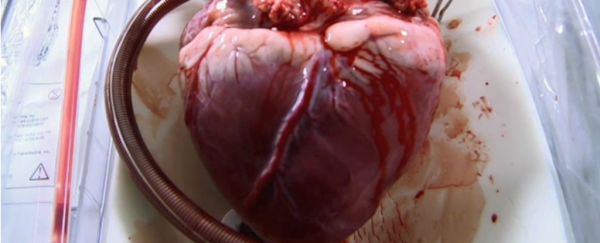Heart disease is the number one killer in the US, with a death toll that surpasses 600,000 people each year. But in a society plagued with broken, ailing hearts, designing a long-term replacement for this vital organ has been pretty tricky.
In 1967, researchers thought they had the perfect solution to the problem: a mechanical heart fuelled by radioactive decay.
That's right, an atomic heart.
For a decade, two separate government-funded teams of researchers, the National Heart Institute (NHI) and the Atomic Energy Agency (AEC), chased the dream of designing a nuclear-powered ticker. They claimed this was the only viable solution to replacing diseased hearts.
The alternative power source for artificial hearts was conventional batteries, but these had some pretty hefty drawbacks: first, they tended to overheat. Plus, they required daily recharging, and even then, they tended to max out after two years of service.
In contrast, a nuclear-powered approach could give patients as many as 10 years, without the trouble of connecting to outside power sources.
The nuclear hearts were powered by plutonium-238, an element that emits close to a century's worth of steady heat due to its natural radioactive decay.
The element has been used to power space satellites and navigation beacons. It powered the New Horizons spacecraft to Pluto, it propels the Voyager probe into deep space, and it drives the Mars rover Curiosity across Martian terrain, Popular Science reports.
The two teams believed they could harness this energy to pump blood through the human body.
Technological roadblocks
Still, they faced many technological challenges. They needed to develop a mechanical pump that the human body wouldn't reject. They also needed to incorporate a safe and efficient engine to power the pump by converting the heat to energy.
The NHI and AEC butted heads about the best way to conduct the research.
For its part, the NHI wanted to develop a partial artificial heart which would assist a still-beating diseased heart in two stages: a nonatomic pump system would be built first, followed by a nuclear-powered engine, the Atlantic reports.
The AEC, on the other hand, wanted to build an integrated, atomic pump and engine that would completely replace the diseased heart for the long-term.
After five years of development, both hearts had issues: While the AEC heart remained clunky and inefficient, the NHI heart was riddled with technological bugs from overheating to letting blood clot up the pump.
And these were just the design flaws. The researchers still needed to address public concern about the ethics and safety of installing atomic devices inside a human body! The effects of extended exposure to radiation, however low the dose, were still unknown.
Heart-shaped weapons
Many believed that a plutonium-powered heart could put patients at risk for a number of health problems, including leukaemia. Those close to the recipients - caregivers, coworkers, loved ones - might also be at risk of radiation poisoning. It was even suggested that if criminals got their hands on these atomic hearts, they could turn them into nuclear weapons.
So, after ten years, the idea flatlined.
Researchers continue to pursue the creation of a fully functional artificial heart. A handful of Biotech companies, including SynCardia, Carmat, and AbioCor are in various stages of developing a truly permanent mechanical heart that could replace a patient's diseased heart and carry them through the rest of their lifetime, The Verge reports.
But they have yet to design a heart, atomic or not, that works long-term within the confines of the human body and doesn't require external drivers or batteries. At best, today's artificial hearts are used to buy patients time as they wait for a human heart transplant.
The technology has a long way to go before it can replace the real thing.
This article was originally published by Business Insider.
More from Business Insider:
